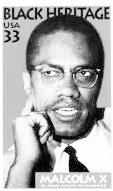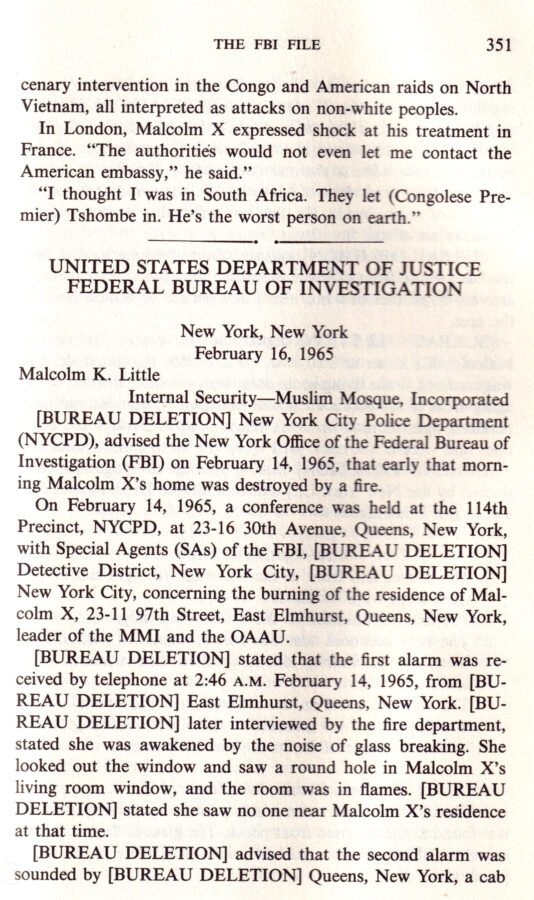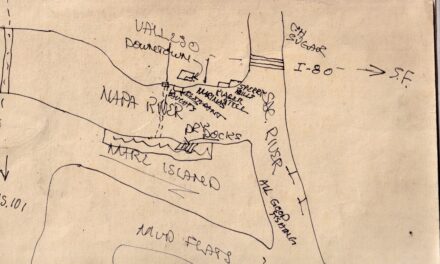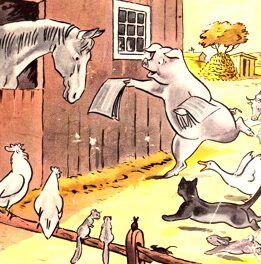Two men framed for killing Malcolm X on February 21, 1965, Muhammad Aziz and Khalil Islam, have been exonerated after all these years. On November 18 the New York Times played the story BIG —a three-deck headline over a two-column front-page story that jumped to fill a two-page spread that included five photos and five related articles. The next day, also on the front page, was a piece about the relief felt by the third defendant, Mujahid Halim, who had confessed on the witness stand and testified that the other two were innocent. He even identified William Bradley, a member of his mosque in Newark, as one of the killers. The Times described Bradley as a former “machine gunner in the Marine Corps.” A physical description of him —which did not fit Aziz or Islam— was provided by eye-witnesses to Malcolm’s assassination and was in FBI files at the time. (After I read the name Bradley, Bob Dylan’s great song Hurricane started playing real loud in my head.)
Manhattan District Attorney Cyrus Vance, Jr., who ordered the belated reinvestigation, made a meaningless apology that might be the understatement of all time: “This points to the truth that law-enforcement over history has often failed to live up to its responsibilities. These men did not get the justice that they deserve.”
Aziz and Islam spent a combined 42 years in prison, as the Times notes, “with years in solitary confinement… in some of New York’s worst maximum security prisons.” And knowing and maintaining all the while that they were innocent.
The FBI withheld documents that would have exonerated them. The presence of undercover cops from the notorious NYPD “Red Squad” was concealed by the prosecution. Ditto the fact that a witness had confirmed Aziz’s alibi. (He was at home.) Islam also had a credible alibi confirmed by witnesses.
District Attorney Vance didn’t wake up conscience-stricken one morning and decide to reopen the case. Journalists, historians, biographers, and others outside the “criminal justice system” had been putting the true story together over the years. Vance was finally compelled by Abdur-Rahman Muhammad’s Netflix documentary, “Who Killed Malcolm X?” to meet with lawyers who had compiled the exonerating evidence (i.e., done his job for him). The DA’s office then spent 22 months confirming the truth. It didn’t matter to Kahlil Islam, who died in 2007. Aziz, now 83, was present in the courtroom when he was officially cleared. “’I do not need this court, these prosecutors or a piece of paper to tell me I am innocent,’ he said in a stern voice that did not shake or falter. ‘I am an 83-year-old man who was victimized by the criminal justice system.'”
The man the authorities came to blame for something that he never done…
David Shanies, one of the civil rights lawyers who forced the DA to act, said the effects of the convictions were “horrific, torturous and unconscionable.” The Times reported, “Both men saw their marriages fall apart and spent the primes of their lives behind bars. Even after their release, they were understood as Malcolm X’s killers, affecting their ability to live openly in society. ‘It affected them in every way you could possibly imagine, them and their families,’ Mr. Shanies said.”
In a sidebar hedded “Questions Left Unanswered,” John Leland asks, “If the Federal Bureau of investigation had as many as seven informants in the Audubon ballroom, why were their accounts not fully shared with the Police Department, the prosecutors and the defense lawyers?” The short answer, of course, is that J. Edgar Hoover hated Malcolm X and had no interest in finding his assassins. Clayborne Carson’s book “Malcolm X: The Police File” runs more than 500 pages, almost every one of which is pockmarked with numerous “[BUREAU DELETION]s.”
As I recall there were about 200 people seated in wooden chairs facing the stage and a large screen on which Malcolm, wearing a dashiki, showed slides from his recent travels. He said he had been an honored guest in Egypt, Lebanon, Nigeria, Ghana and Morocco, and had made a pilgrimage to Mecca where he prayed alongside people of all races. To my surprise he was extremely funny. He said (this is from memory), “You know how the newspapers are always reporting on ‘tribal warfare’ in Africa? You want to know about tribal warfare? You go to the Balkans, go to Yugoslavia —somebody killed somebody’s cousin a thousand years ago and they’re still getting revenge! That’s tribal warfare!”
His theme was that people should be proud they came from Africa. He despised Tarzan movies and riffed about the absurd, deceitful image of the heroic white hero that had been projected into his and everybody else’s brain in childhood. People laughed and loudly agreed. “They say the most beautiful woman that ever lived was Cleopatra,” Malcolm said. “When I was in Egypt I saw images of the real Cleopatra, and she was a dark-skinned sister!” The sisters in the audience appreciated that, and men nodded agreement.
The FBI file of Malcolm X contains this account of the meeting I attended by BUREAU DELETION: “Malcolm X spoke on Africa, particularly about the natural resources and industrial potential of that continent. He also stated that the economy of western Europe and America are dependent on Africa and would collapse if their interests in Africa are lost. This, he claimed, is why the United States and European countries are interested in keeping their foothold in Africa by supporting the Congo regime of Moise Tshombe. He praised the Mau Mau, an anti-white terrorist group that formerly operated in Kenya, and indicated that a Mau Mau was needed in the United States to win freedom and equality for Negroes. He also claimed that black people in America should align themselves with black people of Africa. Malcolm X also talked about the future of the OAAU, indicating that its new philosophy will be one of alignment with Africa.”
The lengthy Times piece about the exoneration of Aziz and Islam ended on page 22. Turning the page I saw this headline running across four columns on page 24: “Bosnia and Herzogovina is on the Brink of Rupture” A drop quote added: “The fuse on the Balkans powder keg has been lit. It must be stamped out.”
And on Sunday, November 21, across five columns of the Times’s front page, there was a color photo of dump trucks lined up at an open-pit mine owned, according to the caption, “by a Chinese company in Kisanfu, Democratic Republic of Congo. The land contains a vast reserve of cobalt, vital to electric car batteries.” The accompanying story made exactly the same point that prescient Malcolm X had made about the Congo’s natural resources at the Audubon Ballroom all those years ago.
The Congo story, too, jumped to fill a two-page spread and was continued the following day. Of course the reporters couldn’t come out and explain that US leaders assumed they could forever exploit the Congo and other African countries by assassinating patriots like Patrice Lumumba and bribing greedy politicians like Mobuto and Tshombe and Joseph Kabila. But they provided a memorable example. After the election of Joseph Kabila the Younger in 2006, according to the Times,
“The Bush administration sent a delegation led by Elaine Chao, then the secretary of labor [AKA Mrs. Mitch McConnell]. Mr. Kabila liked motorcycles, and she presented him with a Harley-Davidson trinket when she greeted him at a lunch. That would be the extent of their interaction, Ms. Chao believed, but members of her delegation urged her to ask for a private meeting, according to Laura Genero, an associate deputy labor secretary who was on the trip. To her surprise, Mr. Kabila complied with a meeting the next day.
Ms. Chao was so unprepared for the invitation that she had to borrow a beige pantsuit from Ms. Genero. She had packed just one work outfit.
The U.S. delegation congratulated Mr. Kabila on his democratic victory and listened as he talked about wanting to expand access to electricity across the nation. One of his aides characterized the meeting as mostly small talk.
But a similar meeting between the new president and Chinese officials played out differently, according to Mr. Kapanga, who was briefed on both the U.S. and Chinese discussions.
The Chinese used the opportunity to begin formal talks with Mr. Kabila that would result in a $6 billion agreement: China would pay for roads, hospitals, rail lines, schools and projects to expand electricity, all in exchange for access to 10 million tons of copper and more than 600,000 tons of cobalt.
The local media called it the ‘the deal of the century,’ and while Mr. Kabila celebrated the agreement, the global financial community reacted more warily, worried Congo was taking on too much debt.
American officials marveled at the deal’s historic scale. In secret cables made public by WikiLeaks, they noted that previous Chinese investment in Congo had been “an informal, somewhat disorganized collection of Chinese businesses” that did not seriously threaten U.S. interests.
Now something much grander was in the making: ‘2,000 miles of roadway linking Orientale and Katanga provinces, 31 hospitals, 145 health centers, two large universities and 5,000 government housing units are pledged,” according to a cable in 2008 from the U.S. embassy in Kinshasa to members of the Central Intelligence Agency, the secretary of state and other officials…'”






